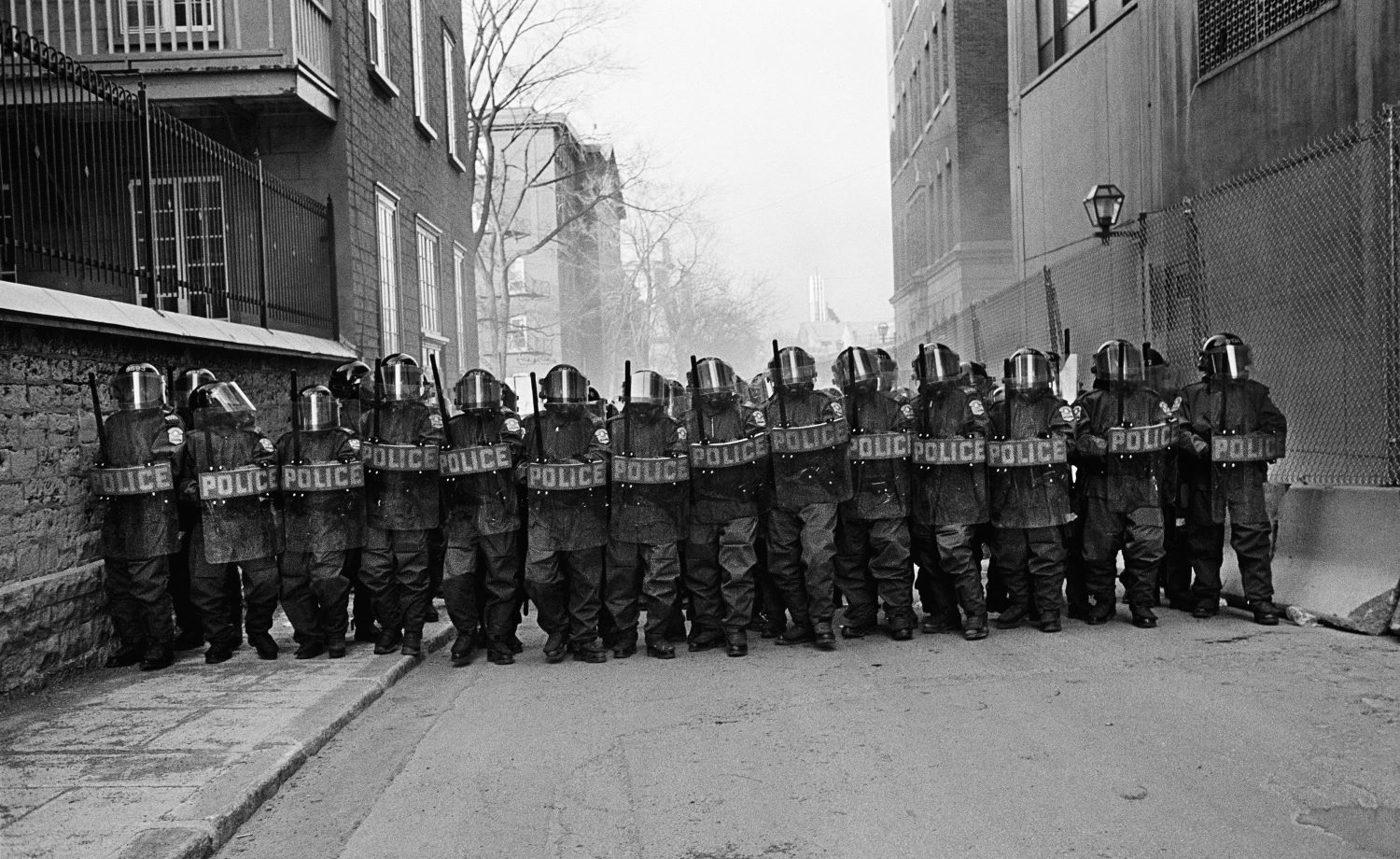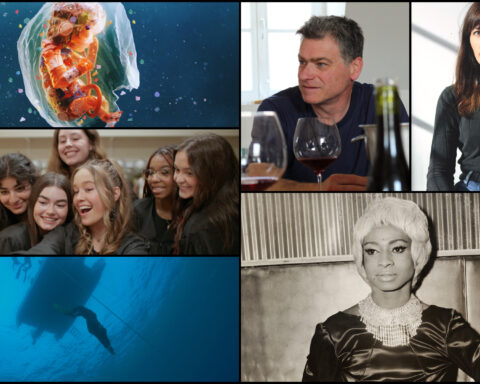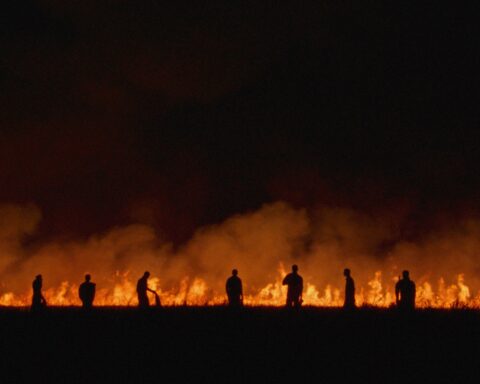In April, 1974, Canadian photographer Elaine Brière documented the idyllic way of life in the Portuguese colony of East Timor, located on an island northeast of Australia, whose inhabitants lived off their traditional trades of farming and fishing. That same month, the Salazar Fascist dictatorship came to an abrupt end in a bloodless coup, and with the fall of the Portuguese regime, a nascent movement toward self-determination intensified. In November 1975 the Democratic Republic of East Timor was formed, and within a few days, Indonesia, its neighbour on the western portion of the shared island, launched a massive sea, air and land invasion. It annexed the country as one of its provinces, and imposed a brutally repressive regime that was condemned by the United Nations, but not by Canada.
Brière had shot only a few rolls of 35mm film of the indigenous people, the villages, and the landscape of East Timor, but they were the last photographs of the pre-invasion way of life. Her powerful images would serve to rally the international solidarity movement for East Timor and launch her career as an internationally recognized documentary photographer. She would return to East Timor after the country regained independence in 2000.
Brière had been introduced to photography in the late 1960s as a student at the University of British Columbia, when she accidentally happened upon one of the most popular books in the history of the medium, The Family of Man, based on a landmark exhibition organized by the Museum of Modern Art in New York in 1955, which purported to show man’s humanity to man. Brière was so inspired that she left university before the end of the academic year, and incredibly, despite her almost complete lack of experience, managed to get a job in Whitehorse with the Yukon Daily News. The experience was like “boot camp,” she says of those early heady days. “I really didn’t know how to develop film. I didn’t know you had to throw the chemicals out, until somebody showed me how to mix them properly. I was staying in a hotel and I’d develop my film in a shared washroom. I’d lock the door when I was loading the film, and people would be hammering down the door to use the washroom…One time I ruined some film of a basketball game, and the sports editor didn’t speak to me for two weeks.”
She persevered but admits that she really “had no idea how difficult it was to be a functioning photographer…I was from a lower-workingclass family in Nanaimo, and I didn’t have any connections. I realize that now since class is very important to me.” Class consciousness for Brière would determine the direction of every facet of her career.Her stint in the Yukon served her well because “there was so much opportunity to be part of ‘something’ in a small town.” She gained a lot of valuable experience, as can be seen in her early images of East Timor. Not only do these images bear the mark of a seasoned professional in terms of composition and technique, they go a long way to explaining the easy rapport that she developed with the East Timorese. In her only book, East Timor Testimony, Brière writes, “Visiting East Timor was like stepping back in time, into a mysterious and hidden world, a place of stoic discipline and stunning beauty, dark secrets, and strong sensuality, a place where unknown smells and sounds flooded the senses and stirred the imagination.”
She and her traveling companion were “adopted” by a Timorese family almost as soon as they arrived, and Brière gained access to the intimacy of daily life in the tiny villages of Baucau and Lospalos, where the people lived in modest thatch houses raised high off the ground on stilts. Perhaps because she was not on assignment, Brière did not feel the pressure of having to “get the right picture” for a newspaper. She only had “six or seven rolls of film,” (just over 200 shots) but used it judiciously to document unique scenes.
The respect that she earned from the villagers is evident in many of her environmental portraits, such as the man carrying clay pots to market. The trusting gaze of the man with his big round eyes wins anyone over, as he pauses willingly for the photographer with his heavy load of clay pots on his shoulders, his right arm encircling the largest pot to balance the load. Four decades later, it is as if he has paused a moment for us, the viewers of the photograph. Her very intimate photograph, “Fatima sleeping, Baucau, 1974”—featuring a barefoot teenage girl peacefully asleep on a bamboo cot with no mattress—was possible because the photographer was like a trusted family member. The photograph would become one of Brière’s most published images.
Brière was deeply affected by her experience with East Timorese people, and after the invasion by Indonesia, her photographs led her to become a committed lifelong activist. Through Noam Chomsky, the American philosopher, scientist and political activist, Brière learned that the international solidarity movement in support of East Timorese independence was very much in need of her photographs. In a short time, they were exhibited in the United States, Holland, Portugal, Japan, Australia, Sweden, Germany, and the United Kingdom. They were published in many books, newspapers, academic journals, posters, and pamphlets, and provided an indispensable visual glimpse into a country that was kept in isolation by military occupation. In an effort to create awareness about East Timor, and in particular to counter complicity by Canadian and Western governments in the continuing occupation of the country, she co-funded ETAN (East Timor Alert Network) and was its national coordinator from 1986 to 1994.
As a committed activist, she made her first documentary film, Bitter Paradise: The Sell-out of East Timor (1996) to explain the plight of the East Timorese. She turned to filmmaking because “film is the popular art form today. If you want to reach a lot of people, if you want to get your word out and you have something to say, film is still one of the best ways to do it. Because people watch films, and people suspend belief if it’s a good film.” But it was her photography that led directly to filmmaking, and admits that she “never would have done filmmaking” otherwise. The few pictures that she took in East Timor became a photo essay, a sequential series of images each of which builds from the other, forming a meaningful narrative. Film offers a further development, one that she calls “layering” of the story. “There’s the visual structure and the conceptual structure,” she says. “Film moves people in a way that would not be possible with a still image. You can bring together still shots, moving images, historical footage, people’s voices, interviews, sounds, music, narration.” Through editing, these elements can be strategically juxtaposed or woven together to make a more complete story.
Bitter Paradise is about her personal journey and transformation from a young idealist to an effective activist. It shows how her life as a documentarian is intertwined with her life as a political advocate. The film is also an exposé of the dark side of Canada’s foreign policy. It traces Canada’s complicity with other Western powers in refusing to admit and condemn the gross human rights violations that were taking place in East Timor. As such, it was deemed too political for the CBC. She refused to consider changes requested by the national broadcaster (such as removing herself from the film), and broke off negotiations, abandoning the possibility of ever having it shown on television across Canada. This was a price that she was prepared to pay for making such an overtly political film. Ironically, Bitter Paradise was shown on national television in Sweden, the United Kingdom, and Australia, and garnered the Best Political Documentary award at the Hot Docs Canadian International Documentary Festival in 1997.
“I miss photography…and I consider myself a photographer when I shoot film,” she said in a recent interview. “Film is one of the most beautiful of the arts, but it is also the most brutal. It takes me an average of five to six years to make a film, developing it, getting funding. It’s a long exercise.”
Although Bitter Paradise drained her, she was soon embarking on another story of outrage. In 2004 she made Betrayed: the Story of Canadian Merchant Seamen, a documentary about the privatisation of Canada’s merchant sea fleet after World War II and the decimation of the CSU (Canadian Merchant Seamen’s Union), a militant union that achieved important social benefits and improved working conditions for workers who had traditionally been exploited in the shipping industry. She resurrected a forgotten page of Canadian history by telling the little-known story of merchant seamen, hailed as heroes during the war, but suddenly cast aside as their union was accused of harbouring communists during the height of McCarthyism.
At first reluctant to get involved in a film that was difficult to fund, Brière says that she was “hooked” after interviewing—for the sake of preserving history—a few of the surviving former members of the union, including luminaries like performer Dave Broadfoot and film and theatre producer Harry Gulkin. They passionately tell the bitter story of how they lost their jobs and became pariahs in Canadian society even after risking their lives for their country and suffering more losses than the sailors in the Canadian Navy. The interviews are intercut with rarely seen footage of the 1949 international shipping strike, sometimes violent, in which longshoremen in many ports around the world refused to unload Canadian ships that were operated by a company-friendly rival American union.
Betrayed was difficult to fund because, according to Brière, “the arts scene in Canada is just not interested in working class issues.” The film was mostly “boycotted by Canadian unions,” speculating that it was because of the lingering distrust of the CSU’s communist roots. Again, her film met with considerable success overseas— in Australia, where it was championed and funded in part by the Maritime Union of Australia.
Despite her forays into filmmaking, Brière admits that a “powerful photograph just lives on” and endures. Like all documentary photographers, it was her search for images of singular power to move the human spirit that lured her to return to an East Timor on the verge of its independence 26 years after her first visit. It was on this visit that she surpassed her earlier photography and film work in terms of visual artistry. Her “Country road near Letefoho, 2000,” which documents a group of villagers returning home from market on a country road, is imbued with a lightness of spirit that comes from having a sense of freedom to think, to move freely, to be lighthearted and relaxed in the knowledge that oppression has come to an end.
Then there is the “Bereaved man, Kelikali, 2000,” whose face is etched with the inexplicable pain of loss, yet who finds comfort in the small black-haired pig that he holds gently in his arms, as if cradling an infant child. The shirt that he is wearing contains vignettes from Winnie-the-Pooh, and the inevitable comparison of his beloved pig with Piglet, the character in the classic children’s story gives the photograph a heightened sense of poignancy. The man’s pig is a prized possession—perhaps just purchased at the market. We don’t know, and it is within the ambiguity of such a photograph that its strength is found.
Brière produced a remarkable series of portraits of survivors each holding a photo of a loved one who was killed or disappeared during the wars of liberation. “Angelina da Conçeicão mourning her son, Maliana, 2000” is a portrait of a middle aged woman holding two faded pictures of her son, one in each hand. Her hands are those of a working woman: strong, large and calloused from a lifetime of toil. In another picture, a young boy, Augusto dos Santos, maybe seven or eight years old, holds a large picture of his father to the camera with the fingertips of both his hands. The father’s face is almost as big as the son’s, and it is the son who is now cradling the father. There are other unforgettable images in this series, such as the family of murdered Manuel Magalhães de Oliveira, whose widow and eight children gathered in a family portrait, one of them holding a small framed snapshot picture of the missing father. The piercing gaze of each of the children contrasts with the averted eyes of their mother, whose pain is too great to share, even in a photograph. What Brière has achieved is a unique series of portraits of both the living and the dead.
Her book is a visual compendium of images that includes the solidarity movement in Canada, particularly during the APEC (Asia-Pacific Economic Cooperation) protests in Vancouver in 1997, supplemented by several essays. One of the most unusual pictures of the protest shows the arrest of a young woman by a large officer who appears to be twice her size. She is handcuffed while he holds her from behind with one hand and from her left ear with the other as she is about to be led into an open paddy wagon. She is stoic and calm, and looks like “a kind of Mona Lisa,” says Brière. The image is infuriating to look at, for it portrays an injustice that hits close to home. It is a Canadian injustice, and not because it is a question of whether the girl should have been arrested or not, but because of the cruel way that she is being treated. Such is the power of Brière’s photography: to move, to inspire, to infuriate, whether at home or in a far away country.
Brière’s credo is that “one of the most important functions photography has is recording history.” She is continuing to do just that with her third film, a documentary currently under production on the struggle for democracy in Haiti, another “troubled” island country, in which she questions Canada’s role. When the film is completed in 2016, she looks forward to returning to her first love—photography— and creating a book on social protest. One senses that the dichotomy between filmmaking and photography will always rule her life as an artist.












